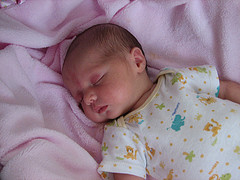
flickr.com/ydog
A parent’s love of his or her child is, hopefully, unconditional, so parents of children who snore will often regard their child’s habit as an adorable trait. Childhood snoring can signify a medical problem, so there may be nothing “cute” about it.
It is estimated that around 3% to 12% of preschool children snore. Most of these children will otherwise look quite healthy and fit. This kind of snoring experienced by children is called primary snoring.
Another two percent of young children will suffer from obstructive sleep apnea syndrome (OSAS), which is being recognized as a severe medical problem. OSAS, in fact, can be a contributing factor to a child’s behavioral problems and difficulties in school.
It is essential to recognize whether your child is a primary snorer, or is suffering from an underlying condition such as obstructive sleep apnea.
Children who snore but are otherwise well and do not display daytime sleepiness with normal sleep patterns will be primary snorers. Children with OSAS, on the other hand, will have a disrupted sleep pattern along with short pauses, snorts and gasps during the night. These children are also often found to have short and poor attention span, and may have difficulty with learning or behavior.
Symptoms that may be associated with OSAS are high blood pressure, obesity, poor weight gain, and large adenoids and/or tonsils. Enlarged adenoids or tonsils can cause frequent mouth breathing accompanied by a hypo nasal speech.
Sleep better! Check out the world's Best MATTRESS TOPPER.
There are tests to verify if a child has OSAS. An overnight sleep study called a nocturnal polysomnography is conducted in a hospital. Generally, these studies are performed at hospitals in major cities, so you may need to travel if this is the option you choose.
Another alternative is to take an audio or video recording, which will require to be interpreted by a sleep specialist. Oxygen and pulse measurements will also be taken overnight while the child sleeps. These tests can also be conducted during a child’s daytime nap. If a child has OSAS, these tests can assist in the diagnosis. The child may, however, still present normal evening if he or she suffers from OSAS.
If it is determined that your child suffers from obstructive sleep apnea, treatment options can include the removal of enlarged tonsils and adenoids. If your child is overweight or has allergies, treating these conditions may also offer relief. If surgery is not an alternative, your child may benefit from CPAP therapy via a nasal mask.
A Pulmonologist, an ENT specialist, or a neurologist should treat children with OSAS. Ask your specialist about their experience in treating these types of concerns, to ensure that they realize the significance of the condition and are able to give the care required.
Don’t forget, tests can sometimes provide inconclusive results, so consider seeing a specialist if you still suspect that your child suffers from OSAS.
It is most likely that your child is a primary snorer, but if he or she falls within the two percent of children with OSAS, treatment is essential and available.
Which one of these is this the world's best foam mattress?
Candidate "A"
Candidate "B" -- you decide 🙂
Tagged with: apnea • childhood snoring
Filed under: Snoring